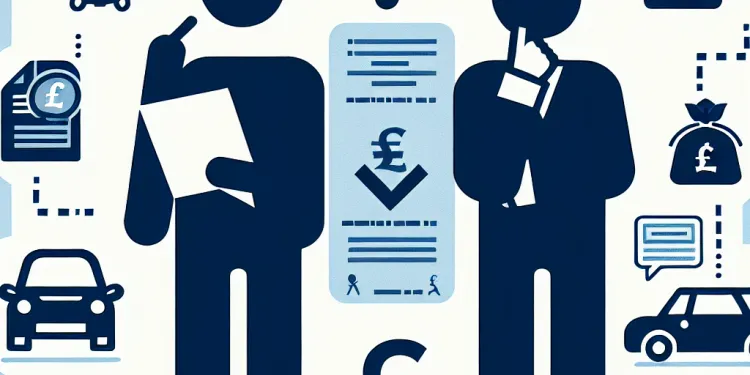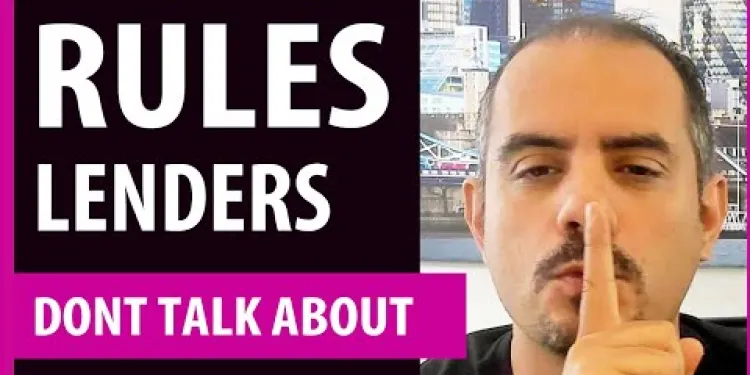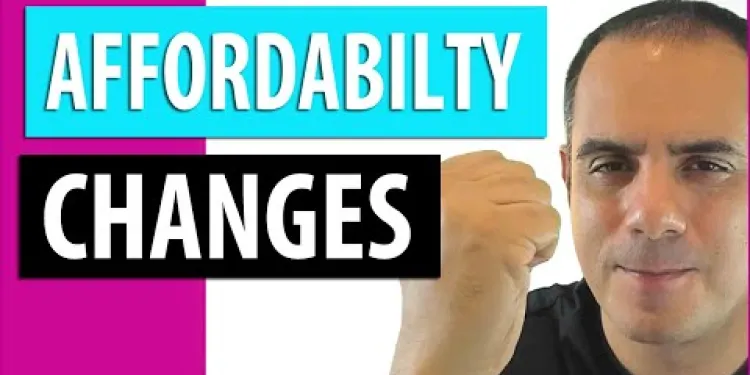Find Help
More Items From Ergsy search
-

Bridging Finance Dangers - Tips on common problems, risks and lending rules in the UK
Relevance: 100%
-

First Time Buyer Buy to Let Finance Options. Lending Criteria on Mortgage and Bridging Finance
Relevance: 61%
-

First Time Buyer Buy to Let Finance Options. Lending Criteria on Mortgage and Bridging Finance
Relevance: 55%
-

HMO Mortgage Truths - how to get the best Finance option including Bridging Loan Criteria
Relevance: 35%
-

What are common signs of being mis-sold car finance?
Relevance: 29%
-

Can Ozempic cause gallbladder problems?
Relevance: 23%
-

What health problems can HPV cause?
Relevance: 22%
-

Can a concussion cause memory problems?
Relevance: 22%
-

What is the seven-year rule relating to inheritance tax?
Relevance: 22%
-

Is sewage a problem on UK beaches?
Relevance: 22%
-

What problems is Ozempic known to cause?
Relevance: 21%
-

UK Mortgage Rules Lenders Don't Talk About - Debt To Income Ratio
Relevance: 21%
-

Why is understanding the terms of car finance important?
Relevance: 21%
-

What is the risk of heart problems with Ozempic?
Relevance: 21%
-

What are the rules regarding smoking?
Relevance: 21%
-

Can relationship problems be resolved to improve mental health?
Relevance: 20%
-

Can mis-sold car finance affect my credit score?
Relevance: 20%
-

What are the rules for writing to an inmate?
Relevance: 20%
-

Do these rules affect nicotine content in e-liquids?
Relevance: 19%
-

Supreme Court Delivers Key Ruling on Electoral Reform
Relevance: 19%
-

Mortgage Regulator removes the need for further affordability stress tests
Relevance: 19%
-

How common is HPV?
Relevance: 19%
-

What is the risk of miscarriage? | NHS
Relevance: 19%
-

Can Ofgem or Octopus Energy change compensation rules in the future?
Relevance: 19%
-

What are the risks associated with a C-section?
Relevance: 18%
-

What are common symptoms of a concussion?
Relevance: 18%
-

Can I modify a car I'm leasing or financing?
Relevance: 18%
-

How does interest rate affect my car finance agreement?
Relevance: 18%
-

Can a finance broker be liable for mis-selling car finance?
Relevance: 18%
-

What are the rules for travel to France, Spain, and Europe on a UK passport?
Relevance: 18%
-

What are the financial implications of water loss for the UK?
Relevance: 18%
-

What are the common risks associated with driving after the age of 70?
Relevance: 18%
-

What should I do if my complaint about mis-sold car finance is rejected?
Relevance: 18%
-

How does leasing compare financially to financing a car?
Relevance: 18%
-

Rules on E-cigarettes to Tighten Amid Concerns Over Youth Vaping
Relevance: 17%
-

Giving Voice - Stammer and Fluency Problems
Relevance: 17%
-

Can high blood pressure lead to other health problems?
Relevance: 17%
-

Are all car finance products potentially subject to mis-selling?
Relevance: 17%
-

Ultimate Guide to Financial Disclosure on Divorce in the UK
Relevance: 17%
-

What are the common side effects of ketamine?
Relevance: 17%
Bridging Finance Dangers: Tips on Common Problems, Risks, and Lending Rules in the UK
Understanding Bridging Finance
Bridging finance is a short-term loan used to bridge a financial gap, often taken out to secure a property while waiting for long-term funding. While it can be useful, it also comes with significant risks, particularly in the UK. Borrowers should carefully evaluate their need for such finance and understand the precise terms before proceeding.
Common Problems with Bridging Loans
One of the most common issues faced by borrowers is underestimating the length of time they'll need the bridging loan. This miscalculation can lead to financial strain, as these loans typically have high interest rates. Additionally, if the borrower's strategy to exit the loan fails (e.g., a property sale falling through), they may face penalties or increased costs. It's also crucial to be aware of potential delays in the legal process, which can further extend the loan term.
Risks Associated With Bridging Finance
The high interest rates are a significant risk, often compounded by additional fees such as arrangement fees, legal fees, and exit fees. If repayments are missed, penalties can quickly accumulate, exacerbating financial stress. The UK market fluctuates, and changes in property values can impact the borrower's ability to repay through planned assets. As a form of secured loan, there is also the risk of property repossession if repayments are not met.
Lending Rules in the UK
In the UK, bridging finance is regulated by the Financial Conduct Authority (FCA) when the loan is used for a residential property occupied or intended to be occupied by the borrower or a family member. This regulation aims to protect borrowers by requiring transparent lending practices and safeguarding against unethical behavior. However, commercial bridging finance remains unregulated, demanding that borrowers exercise considerable caution and diligence. Borrowers should shop around, comparing offers from FCA-regulated lenders, and thoroughly review all terms and conditions before entering into any agreement.
Bridging Finance Dangers: Tips on Common Problems, Risks, and Lending Rules in the UK
Understanding Bridging Finance
Bridging finance is a short-term loan. People use it to fill a money gap. It helps when buying a house while waiting for other money, like a mortgage. It can be helpful, but it also has big risks. In the UK, it is important to know these risks. Think carefully if you need this loan and know all the rules before saying yes.
Common Problems with Bridging Loans
Many people don't realize how long they will need the loan. This can lead to money problems because these loans have high interest rates. If plans change, like if a house sale does not happen, costs can go up. There can also be delays in paperwork, making the loan last longer.
Risks Associated With Bridging Finance
These loans have high interest rates. There are also other costs, like fees for setting up the loan and ending it. If payments are late, you will pay extra money as a penalty. The value of houses can change, affecting your ability to pay back the loan. If you do not pay, you might lose your house.
Lending Rules in the UK
In the UK, some bridging loans are regulated. This happens if you or your family live in the house linked to the loan. This rule is to keep lending fair and honest. But loans for business use are not covered, so be very careful. Look at different loans from trusted companies and read all the details before you agree.
Helpful tips: Use a calculator to see if you can afford the loan. Ask someone you trust for advice. You can also use simple programs that read text out loud to help you understand better.
Frequently Asked Questions
What is bridging finance and how does it work?
Bridging finance is a short-term loan used to 'bridge' the gap between buying a new property and selling an existing one. It provides immediate funding and is often used when a property transaction requires quick completion. Borrowers typically repay the loan once they sell their property or secure long-term financing.
What are the typical uses of a bridging loan in the UK?
Bridging loans are used for various reasons, including purchasing a property at auction, buying a new home while waiting for the sale of an existing one, property development projects, and refinancing short-term debts.
What are the risks associated with bridging finance?
The main risks include high-interest rates, short repayment terms, and the potential for property devaluation. If properties do not sell or additional finance isn't secured in time, borrowers could face financial difficulties or even repossession.
How quickly can I receive funds through a bridging loan?
Funds from a bridging loan can be available in as little as 24 to 48 hours after approval, depending on the lender's processes and your individual circumstances. This speed makes them appealing for time-sensitive transactions.
What criteria do lenders use to approve bridging loans?
Lenders typically assess the value of the property or asset being used as security, the borrower's creditworthiness, exit strategy (how and when the loan will be repaid), and sometimes the borrower’s income and overall financial status.
Are bridging loans regulated in the UK?
Bridging loans can be regulated or unregulated in the UK. Regulated bridging loans are those that are secured against a borrower’s home and are regulated by the Financial Conduct Authority (FCA). Unregulated loans, often for investment properties, aren't covered by the same protections.
Can I use a bridging loan for business purposes?
Yes, bridging loans can be used for business purposes, such as purchasing commercial property, expanding business premises, or refinancing corporate debts. For commercial uses, these loans are usually unregulated.
What are the common pitfalls to avoid when taking a bridging loan?
Common pitfalls include underestimating costs, failing to have a solid exit strategy, not shopping around for competitive rates, and not understanding the full terms and conditions of the loan agreement.
What are typical interest rates for bridging loans?
Interest rates for bridging loans in the UK can range from 0.4% to 1.5% per month. Rates vary based on the lender, type of property, loan amount, and borrower's situation. It's important to compare rates from different lenders.
What is an exit strategy in bridging finance?
An exit strategy is a plan for repaying the bridging loan, typically through the sale of property, refinancing to a traditional mortgage, or another financial arrangement. Lenders require a clear exit strategy as part of the loan approval process.
How does a bridging loan differ from a traditional mortgage?
Bridging loans are short-term, typically lasting a few months to a year, with higher interest rates, while traditional mortgages are long-term with lower rates. Bridging loans offer faster access to funds and are interest-only.
Can I obtain a bridging loan with bad credit?
While having good credit can make obtaining a bridging loan easier and cheaper, some lenders specialise in offering bridging finance to individuals with adverse credit by focusing more on the property's value and exit strategy.
What fees are associated with bridging loans?
Fees may include arrangement fees, valuation fees, legal fees, and exit fees. These can add significantly to the overall cost, so borrowers should request a full list of potential fees before committing to a loan.
Is there a maximum loan-to-value (LTV) for bridging loans?
Yes, most lenders offer bridging loans up to 75% LTV, although some may be willing to consider higher LTVs depending on the borrower's circumstances and the specific property or asset being used as security.
How can I minimize the risks of taking out a bridging loan?
To minimize risks, ensure you have a detailed and feasible exit strategy, fully understand all costs and fees, borrow only what you need, and consider speaking to a financial advisor or mortgage broker for expert guidance.
What is bridging finance and how does it work?
Bridging finance is a short-term loan. It helps when you need money quickly.
For example, if you want to buy a new house but haven't sold your old one yet, bridging finance can help. You use it to pay for the new house while you wait to sell the old one.
Bridging finance is like a bridge. It connects the time between needing money and getting money.
If you need help understanding, you can use pictures or ask someone to explain it with simple words.
Bridging finance is a short-term loan. It helps you buy a new home before you sell the old one. It gives you money right away when you need it fast. You pay back the loan when you sell your old home or get a long-term loan.
How do people use a bridging loan in the UK?
A bridging loan is a type of money you can borrow for a short time. Here are some ways people use it:
- Buying a home: Sometimes, people need a loan to buy a new house before they sell their old one.
- Fixing a house: People might borrow this money to make repairs or improvements on a property.
- Buying property quickly: If someone needs to buy a property fast, they might use a bridging loan.
To help understand this better, you can:
- Use pictures or drawings to show how the loan works.
- Ask a friend or family member to explain it in different ways.
- Use apps or tools that read text out loud.
Bridging loans can help you in many ways. You can use them to buy a house at an auction. They can also help you buy a new home while you wait to sell your current home. Bridging loans are good for projects like building houses, and for paying off short-term debts.
If you find reading tough, you can try using audiobooks or speech-to-text tools to help. Breaking down information into smaller parts can also make it easier to understand.
What are the risks of bridging finance?
Bridging finance is a type of loan. Here are some things to watch out for:
- High Interest Rates: You might have to pay a lot of extra money.
- Short Loan Time: You have to pay it back quickly.
- Property Repossession: You could lose your home if you can't pay.
It helps to talk to someone who knows about money, like a financial advisor.
Big risks are high-interest rates, short time to pay back money, and the chance that property loses value. If properties don't sell or you can't get more money in time, you might have money troubles or lose your property.
How fast can I get money from a bridging loan?
You can get money from a bridging loan fast. It can take only 1 to 2 days after the loan is approved. How fast you get it depends on the lender and your situation. This makes bridging loans good for things you need to do quickly.
How do lenders decide to give bridging loans?
Lenders look at how much the property or asset is worth because it will be used as security. They check if the borrower has a good credit history. They also want to know the exit strategy, which means how and when the loan will be paid back. Sometimes, they also look at how much money the borrower earns and their overall financial situation.
If you need help understanding this, you can ask someone to explain the words you don't know. Using a dictionary can help, too. Highlighting important parts can make it easier to read. You can also read out loud to help you understand better.
Are bridging loans controlled by rules in the UK?
A bridging loan is a short-term loan to help buy a new home before selling the old one. In the UK, some bridging loans have rules to keep them safe. But not all loans are the same.
If you need help to understand, ask someone you trust. Tools like picture cards can also help explain loans.
In the UK, there are two types of bridging loans: regulated and unregulated.
Regulated bridging loans are loans that you take out using your home as security. These loans are watched over by a group called the Financial Conduct Authority (FCA). The FCA makes sure everything is done fairly.
Unregulated loans are different. They are often used to buy investment properties. These loans do not have the same rules or protection as regulated ones.
If you find it hard to understand, you can ask someone to help explain. You can also use tools like text-to-speech, which reads the text out loud for you.
Can I get a bridging loan to help my business?
Yes, businesses can use bridging loans. They can help buy buildings, make business spaces bigger, or pay off business debts. These loans for business usually have fewer rules.
What mistakes should you watch out for with a bridging loan?
A bridging loan is a short-term loan. Here are some mistakes to avoid:
- High Interest Rates: Check the interest rates. They can be high.
- Short Repayment Time: You have to pay it back quickly. Make sure you can do that.
- Extra Fees: Look out for extra charges. They add up.
- Not Planning Ahead: Have a clear plan for paying back.
You can use these tools to help:
- Ask someone you trust to explain it to you.
- Use a calculator to see how much you need to pay back.
- Write down a plan for your payments.
Here are some common mistakes people make:
- They think things will cost less than they do.
- They don't have a good plan for when they want to stop.
- They don't compare prices to find the best deal.
- They don't read all the rules and details of the loan.
It's helpful to:
- Write down a list of costs to make sure nothing is missed.
- Make a plan for what you will do at the end.
- Use a calculator to compare different prices.
- Ask someone to explain the loan to you if it is hard to understand.
What are the usual interest rates for bridging loans?
A bridging loan is a short-term loan. It helps you until you get other money or a long-term loan. The interest rate is the extra money you pay back on top of the loan.
The interest rate for a bridging loan is usually higher than for a regular loan. It can be between 0.5% and 2% each month.
If you want to understand better or need help, you can:
- Ask a grown-up to explain it to you.
- Look at pictures or videos about bridging loans.
- Use a calculator to see how much extra money you would pay.
Interest rates for bridging loans in the UK are like the extra money you pay back when you borrow money. These rates can go from 0.4% to 1.5% each month. The rate you get can change depending on who you borrow from, what kind of building you want, how much money you borrow, and your own money situation. It's a good idea to look at rates from different places before you decide.
What is an exit plan in bridging finance?
Bridging finance is a short-term loan to help people when they need money quickly. An exit plan tells how you will repay this loan. It is like a promise that shows how and when you will pay back the money.
Here are some ways to have an exit plan:
- Sell a house or property to get the money.
- Get a loan from a bank to pay it back.
- Use savings or other funds.
Tools like calendars or lists can help you track when to pay back. You can ask someone you trust, like a family member or a friend, to help you make a plan.
An exit plan is a way to pay back a quick loan. You can do this by selling a house, getting a regular loan, or some other money plan. Lenders need to see your exit plan to say yes to the loan.
What is the difference between a bridging loan and a regular mortgage?
A bridging loan and a regular mortgage are two ways to borrow money for a house.
Bridging Loan:
- A bridging loan is a short-term loan.
- People use it when they need money quickly.
- It helps to "bridge" or cover the time until more money comes in.
Regular Mortgage:
- A regular mortgage is a long-term loan.
- People use it to buy a house and pay over many years.
- It usually has smaller monthly payments.
If you need help, ask someone you trust, like a family member. You can also use pictures or videos to understand better. Tools like text-to-speech apps can read aloud to you.
Bridging loans are quick loans that last a few months to a year. They have higher interest rates. Traditional mortgages are loans that last a long time. They have lower interest rates. Bridging loans give you money fast and you pay only the interest at first.
Can I get a bridging loan if I have bad credit?
If you have good credit, getting a bridging loan can be easier and cost less. But don't worry if your credit isn't great! Some lenders help people with bad credit. They look more at how much the property is worth and how you plan to pay back the loan.
What costs come with bridging loans?
There are different kinds of fees you might have to pay when getting a loan.
These fees can be:
- Arrangement fees
- Valuation fees
- Legal fees
- Exit fees
These fees can make the loan more expensive. It's important to ask for a list of all the fees before you take the loan.
Using a calculator to add up the fees can help. If you find it confusing, ask someone you trust for help.
Is there a limit to how much you can borrow with a bridging loan?
A bridging loan helps you borrow money until you get more money later. It's like a short-term loan. But there is a limit to how much of the property's value you can borrow. This is called the Loan-to-Value (LTV) ratio. For example, if the LTV is 70%, you can borrow up to 70% of your property's value.
To help understand this:
- Use a calculator to see what 70% of your property's value is.
- Ask someone you trust, like a family member or friend, for help if you're unsure.
- Talk to a financial advisor for clear advice about loans.
Yes, most banks and lenders give bridging loans up to 75% of the property's value. Some might offer more if they see special reasons or if the property is valuable.
How can I make taking a bridging loan safer?
A bridging loan is a short-term loan. It helps you buy a new home while you wait to sell your old one.
Here are some ways to make it safer:
- Talk to a money expert. They can give you good advice.
- Borrow only what you need. This way, you have less to pay back.
- Check if you can pay the loan back on time. Make sure you have a plan.
- Read all the rules in the loan paper. Know what happens if you don’t pay back on time.
- Use a calculator online to see how much you need to pay each month.
Ask for help if you need it. It is okay to get support to understand better.
To keep safe, have a clear and simple plan for leaving. Make sure you know all the costs and fees. Only borrow the money you really need. It can be helpful to talk to a money expert or a mortgage helper to get good advice.
Useful Links
- Ergsy carfully checks the information in the videos we provide here.
- Videos shown by Youtube after a video has completed, have NOT been reviewed by ERGSY.
- To view, click the arrow in centre of video.
- Most of the videos you find here will have subtitles and/or closed captions available.
- You may need to turn these on, and choose your preferred language.
- Go to the video you'd like to watch.
- If closed captions (CC) are available, settings will be visible on the bottom right of the video player.
- To turn on Captions, click settings .
- To turn off Captions, click settings again.
More Items From Ergsy search
-

Bridging Finance Dangers - Tips on common problems, risks and lending rules in the UK
Relevance: 100%
-

First Time Buyer Buy to Let Finance Options. Lending Criteria on Mortgage and Bridging Finance
Relevance: 61%
-

First Time Buyer Buy to Let Finance Options. Lending Criteria on Mortgage and Bridging Finance
Relevance: 55%
-

HMO Mortgage Truths - how to get the best Finance option including Bridging Loan Criteria
Relevance: 35%
-

What are common signs of being mis-sold car finance?
Relevance: 29%
-

Can Ozempic cause gallbladder problems?
Relevance: 23%
-

What health problems can HPV cause?
Relevance: 22%
-

Can a concussion cause memory problems?
Relevance: 22%
-

What is the seven-year rule relating to inheritance tax?
Relevance: 22%
-

Is sewage a problem on UK beaches?
Relevance: 22%
-

What problems is Ozempic known to cause?
Relevance: 21%
-

UK Mortgage Rules Lenders Don't Talk About - Debt To Income Ratio
Relevance: 21%
-

Why is understanding the terms of car finance important?
Relevance: 21%
-

What is the risk of heart problems with Ozempic?
Relevance: 21%
-

What are the rules regarding smoking?
Relevance: 21%
-

Can relationship problems be resolved to improve mental health?
Relevance: 20%
-

Can mis-sold car finance affect my credit score?
Relevance: 20%
-

What are the rules for writing to an inmate?
Relevance: 20%
-

Do these rules affect nicotine content in e-liquids?
Relevance: 19%
-

Supreme Court Delivers Key Ruling on Electoral Reform
Relevance: 19%
-

Mortgage Regulator removes the need for further affordability stress tests
Relevance: 19%
-

How common is HPV?
Relevance: 19%
-

What is the risk of miscarriage? | NHS
Relevance: 19%
-

Can Ofgem or Octopus Energy change compensation rules in the future?
Relevance: 19%
-

What are the risks associated with a C-section?
Relevance: 18%
-

What are common symptoms of a concussion?
Relevance: 18%
-

Can I modify a car I'm leasing or financing?
Relevance: 18%
-

How does interest rate affect my car finance agreement?
Relevance: 18%
-

Can a finance broker be liable for mis-selling car finance?
Relevance: 18%
-

What are the rules for travel to France, Spain, and Europe on a UK passport?
Relevance: 18%
-

What are the financial implications of water loss for the UK?
Relevance: 18%
-

What are the common risks associated with driving after the age of 70?
Relevance: 18%
-

What should I do if my complaint about mis-sold car finance is rejected?
Relevance: 18%
-

How does leasing compare financially to financing a car?
Relevance: 18%
-

Rules on E-cigarettes to Tighten Amid Concerns Over Youth Vaping
Relevance: 17%
-

Giving Voice - Stammer and Fluency Problems
Relevance: 17%
-

Can high blood pressure lead to other health problems?
Relevance: 17%
-

Are all car finance products potentially subject to mis-selling?
Relevance: 17%
-

Ultimate Guide to Financial Disclosure on Divorce in the UK
Relevance: 17%
-

What are the common side effects of ketamine?
Relevance: 17%


